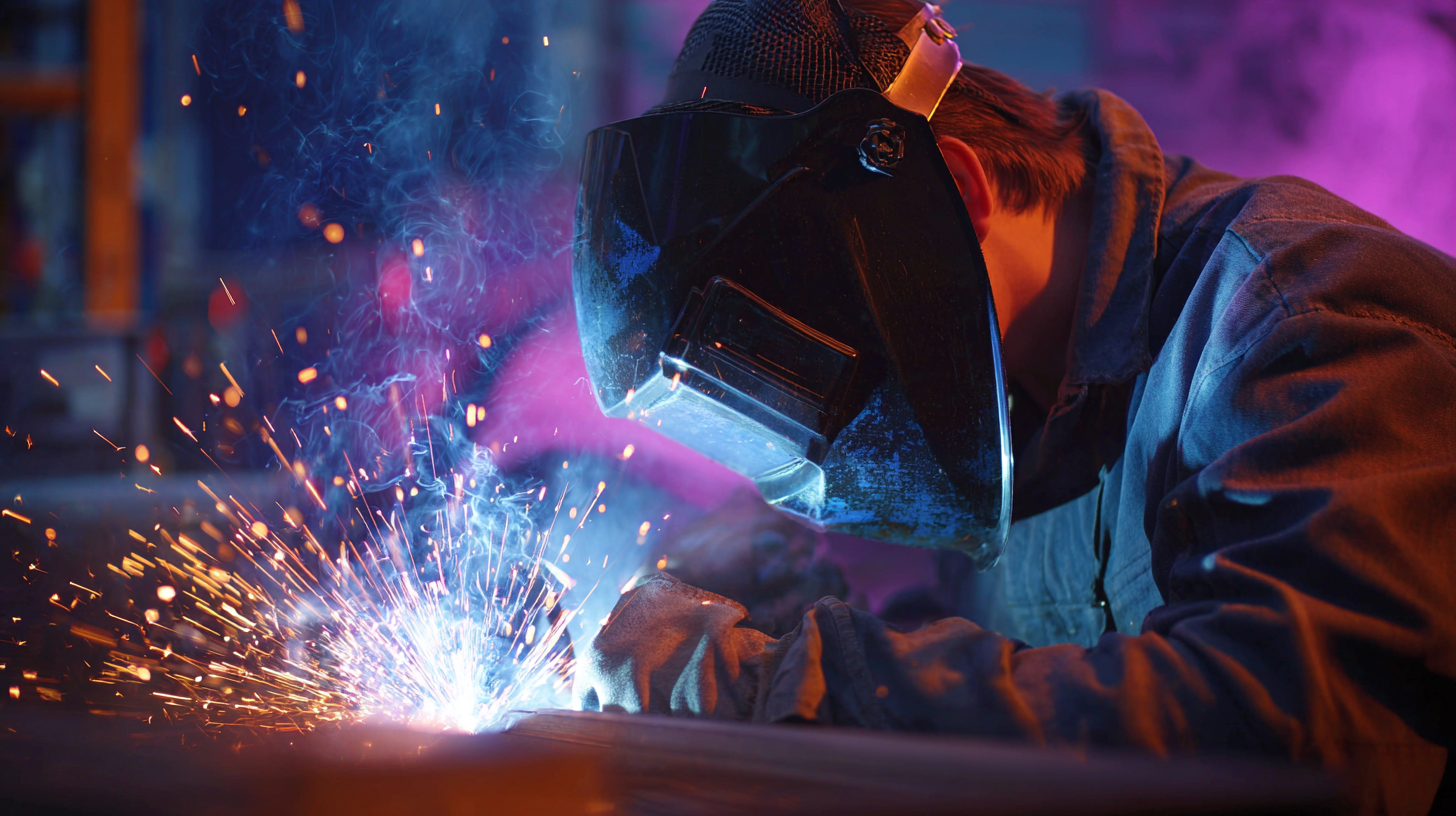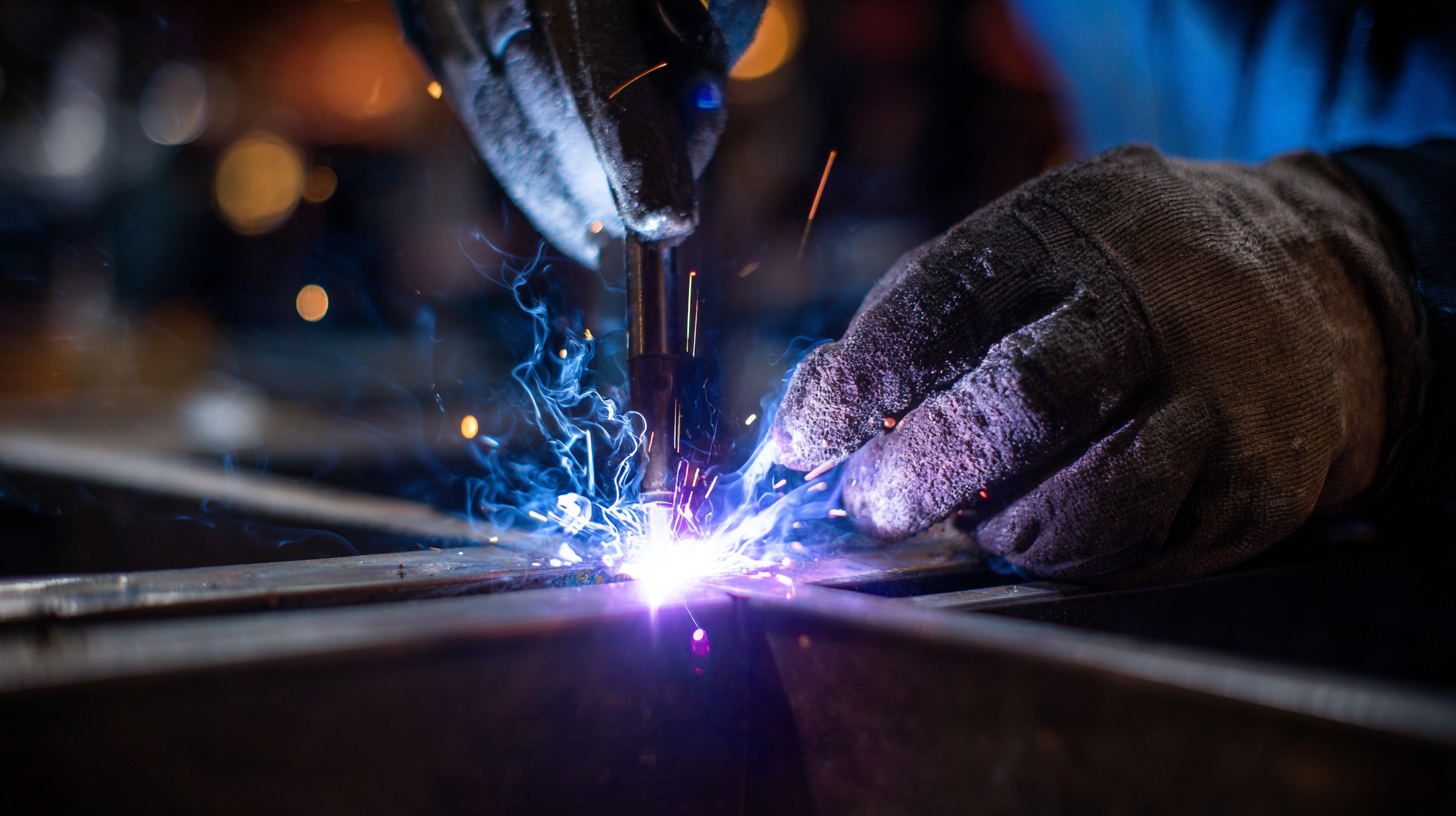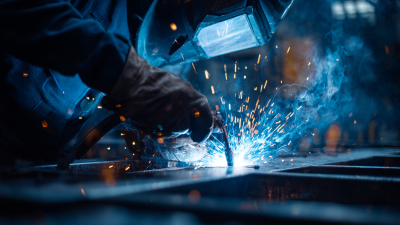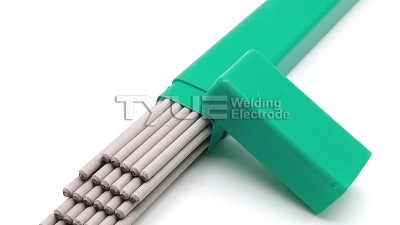7 Essential Tips for Mastering Consumable Welding Techniques Effectively
Table of Contents
- Understanding Consumable Welding Techniques: Key Concepts and Importance
- Essential Safety Practices in Welding to Avoid Common Hazards
- Analyzing the Role of Filler Materials in Consumable Welding Efficiency
- Identifying the Right Equipment for Different Welding Projects
- Techniques for Achieving Optimal Weld Quality and Strength
- Continuous Learning: Training Opportunities and Certifications in Welding
- Mastering Low Temperature Welding: The Benefits of AWS E8018-C1 Low Hydrogen ARC Electrodes
- FAQS
- Conclusion
- Related Posts
Hey there! If you're into consumable welding, you probably know how super important it is to be on top of the best techniques — not just for getting stuff done faster, but also for making sure the welds are solid. I read recently that the international welding scene predicts the global demand for welding consumables will hit around $20 billion by 2025 — that’s a huge jump, mainly because of booming industries like construction and manufacturing. At Wenzhou Tianyu Electronic Co., Ltd., we've been making welding electrodes and consumables for over 22 years now, and trust me, we totally get how vital it is to stay ahead of the trends and keep our customers happy. We offer a wide range of top-quality products, like stainless steel, carbon steel, and low-alloy electrodes, all designed to perform well across different jobs. In this blog, I want to share seven handy tips to help you master consumable welding techniques — so you can sharpen your skills and keep up with industry growth without breaking a sweat.

Understanding Consumable Welding Techniques: Key Concepts and Importance
Getting a solid grasp of consumable welding techniques is pretty much essential if you want to pull off high-quality welds and make sure your products last. The market for welding equipment, accessories, and consumables is actually heading towards a massive $32.5 billion by 2026 — so, clearly, this area is growing super fast. Techniques like submerged arc and electroslag welding do more than just boost efficiency; they also help prevent equipment from corroding, which is a big deal, especially in industries where conditions can be pretty tough.
Choosing the right consumables really matters, especially when you're working with tricky materials like duplex stainless steels. For example, you’ve gotta compare how quickly different consumables deposit material — that’s key for getting the welds strong and free of defects. Plus, sudden advancements in wire and arc additive manufacturing are opening up new possibilities for keeping quality on point and making precise parts. These innovations help tackle big challenges like managing heat input and avoiding issues like shrinkage or residual stresses.
And if you look at the underwater welding market, it’s clear that all these different materials and methods are fueling industrial growth. It’s a constantly changing scene, and keeping up with the latest stuff is pretty exciting.
Essential Safety Practices in Welding to Avoid Common Hazards
Welding can be pretty rewarding, but let’s be honest — it’s also pretty dangerous if you’re not careful. First off, always gear up with the right protective gear. That means a good welding helmet with the right shade, gloves, and flame-resistant clothing to keep you safe from sparks and UV rays. Oh, and make sure your workspace isn’t cluttered with anything flammable — avoiding fire hazards is kinda a no-brainer but super important.
Another thing that often gets overlooked? Ventilation. Welding fumes can be nasty, so it’s best to work somewhere with good airflow or use exhaust systems if you can. It’s also a good habit to stay alert and keep your work area tidy — little things like that can save you from accidents. Don’t forget to check your equipment regularly for any issues; a faulty tool can turn dangerous quick. Ultimately, putting safety first not only keeps you safe but also helps you get better at welding, making the whole experience way more enjoyable and productive.
7 Essential Tips for Mastering Consumable Welding Techniques Effectively
| Tip Number | Welding Technique | Essential Practice | Safety Precautions |
|---|---|---|---|
| 1 | MIG Welding | Maintain a steady hand and speed | Wear protective gloves and helmet |
| 2 | TIG Welding | Clean the base metal thoroughly | Ensure adequate ventilation |
| 3 | Stick Welding | Select the right electrode | Use a helmet with proper shade |
| 4 | Flux-Cored Welding | Keep the welding area clean | Use protective clothing |
| 5 | Submerged Arc Welding | Monitor the arc length closely | Keep flammable materials away |
| 6 | Laser Welding | Adjust focus for optimal penetration | Avoid direct eye exposure |
| 7 | Electron Beam Welding | Control the vacuum conditions | Use proper shielding against radiation |
Analyzing the Role of Filler Materials in Consumable Welding Efficiency
You know, when it comes to consumable welding techniques, a lot depends on picking the right filler materials and making sure they’re good quality. These fillers do more than just fill in the gaps—they give your welds the strength and durability they need to hold up. It’s pretty interesting that the global market for welding consumables is expected to hit around USD 34.9 billion by 2030—that just shows how much industries are leaning on top-notch filler materials these days. Understanding what kind of filler works best for different metals can really make a huge difference in how successful your weld turns out.
If you’re serious about mastering consumable welding, my advice? Focus on choosing the right filler for what you’re working on. For example, tweaking the arc welding current can really change the toughness of your welds. Proper settings can actually improve the structural integrity, especially when working with materials like A36 carbon steel. Plus, using newer techniques like Cold Metal Transfer (CMT) can make everything more precise and control heat better—way better than traditional methods, honestly. It can really boost the efficiency of how you use your filler materials.
And hey, don’t forget to keep an eye on the latest trends and tech updates in the welding world. The market for welding equipment and accessories is booming, which means there’s a lot of cool new stuff coming out that can make your job easier and better. By staying in the loop and adopting the latest in welding consumables and techniques, you can crank out higher quality work and get more done in less time. It’s all about leveraging those advancements to stay ahead in the game.
Identifying the Right Equipment for Different Welding Projects
When you're diving into welding, picking the right gear for your project is pretty important if you wanna get good results. First off, take a moment to look at the materials you'll be working with. For example, MIG welding works really well for thin metals, while TIG is a better choice for more delicate jobs, like on stainless steel. Make sure your welder can handle the thickness and type of metal you’re dealing with — nobody wants unexpected surprises or wrecked pieces!
Oh, and don't forget about safety gear. It's super worth investing in some quality helmets and gloves that fit well and suit the kind of welding you're doing. A good helmet not only shields your face from that blinding light but also helps you see better during tricky maneuvers. Seriously, having the right protective equipment is just as vital as the tools you’re using — it keeps you safe and makes your work smoother.
And hey, don’t slack off on maintenance. Regularly check and clean your tools so everything stays in top shape. This simple step can make a big difference in how your welds turn out and how quickly you can get stuff done. Bottom line — choosing the right gear, staying safe, and keeping everything in good shape will make your welding projects way more successful and way less stressful.
Techniques for Achieving Optimal Weld Quality and Strength
 Getting that perfect weld quality and strength is a big deal for anyone in the welding game. According to the American Welding Society, almost 45% of weld defects actually come down to not-so-great techniques, so knowing your consumable welding methods really matters.
Getting that perfect weld quality and strength is a big deal for anyone in the welding game. According to the American Welding Society, almost 45% of weld defects actually come down to not-so-great techniques, so knowing your consumable welding methods really matters.
One thing that's super important is controlling the heat input—if you pump in too much, the weld can get weak, but if you don’t heat enough, you might end up with gaps and poor penetration. Studies show that keeping the right interpass temperature helps create a more consistent microstructure, which in turn boosts the mechanical properties of the welds.
Another crucial point is choosing the right filler material. Picking the proper consumable isn’t just about tensile strength; it also impacts how well the weld resists corrosion and fatigue over time. A paper I read in the Journal of Materials Processing Technology mentioned that using fillers with the right chemical makeup actually improves the overall performance of the weld.
When you combine good technique with the right materials, you can seriously make your welds tougher and more reliable—setting you up to meet, or even beat, industry standards for quality and strength.
Continuous Learning: Training Opportunities and Certifications in Welding
If you wanna really succeed in the welding world, staying on top of your learning game is a must. Honestly, putting some time into training and snagging certifications isn’t just about leveling up your skills—it also makes you look more legit as a pro. Whether you’re just starting out or you’ve been in the biz for years, jumping into workshops and courses is a great way to learn about the latest techniques and safety rules. It’s all about keeping yourself sharp and in the know.

Now, if you’re diving into consumable welding techniques, a good first step is to get familiar with the basic gear and materials. Here’s a tip: always pick the right filler material for whatever job you’re doing. It might seem small, but that choice really affects how strong and durable your weld will be—and how well everything performs in different conditions. Another thing — practice makes perfect. Regular hands-on practice helps you refine your skills and become more confident, especially when things get real in the field.
And hey, don’t forget about certifications. Getting recognized by respected organizations not only proves you’ve got the skills, but it also pushes you to stay updated with industry standards. Overall, keeping a continuous learning mindset and following these simple tips will seriously boost your ability with consumable welding techniques—and, measured progress in this craft always feels good, right?
Mastering Low Temperature Welding: The Benefits of AWS E8018-C1 Low Hydrogen ARC Electrodes
Mastering low temperature welding opens new avenues for industries where precision and reduced thermal impact are crucial. Among the tools available, the AWS E8018-C1 low hydrogen ARC electrode stands out due to its unique composition and characteristics. Specifically, W606Fe (AWS E8018-C1) consists of an iron powder core combined with low hydrogen potassium coating, which not only ensures minimal hydrogen pick-up but also enhances the overall welding process. This is particularly beneficial in applications involving high-strength steels where avoiding post-weld cracking is essential.
One of the primary advantages of using AWS E8018-C1 electrodes is their ability to produce high-quality welds in low-temperature conditions. The low hydrogen content in these electrodes reduces the risk of hydrogen-induced cracking, making it a preferred choice for critical applications such as pressure vessels, pipelines, and structural components. Additionally, the iron powder improves the deposition efficiency, allowing for faster welding speeds without compromising weld integrity. This combination of factors makes W606Fe an excellent option for welders aiming for both performance and reliability in diverse working environments.
With the rising demand for robust and efficient welding solutions, mastering the use of AWS E8018-C1 electrodes can significantly enhance a welder's skill set. As industries continue to evolve, adopting techniques that leverage low temperature welding can lead to improved productivity and cost-effectiveness, making it an indispensable asset in modern fabrication processes.
FAQS
: Always wear a welding helmet with proper shading, gloves, and flame-resistant clothing to protect against sparks and UV radiation.
Proper ventilation is crucial because welding fumes can be harmful. Working in well-ventilated areas or using exhaust systems helps maintain safe air quality.
Keep your workspace free from flammable materials to significantly reduce the risk of fire hazards.
Regularly inspect your equipment for defects or malfunctions, as equipment failure can lead to dangerous situations.
Prioritize the selection of appropriate filler materials tailored to the specific application and the types of metals being welded.
Optimizing the arc welding current can improve the mechanical properties and structural integrity of the weld joints, especially for materials like A36 carbon steel.
Advanced techniques such as Cold Metal Transfer (CMT) can offer advantages over traditional methods in terms of precision and heat control.
Assess the materials you'll be working with; for example, use MIG welding for thin metals and TIG welding for delicate work on stainless steel.
Regular maintenance of your tools ensures they function properly, which can significantly impact the quality of your welds and the efficiency of your projects.
The global welding consumables market is projected to reach USD 34.9 billion by 2030, highlighting the increasing reliance on high-quality filler materials essential for various industries.
Conclusion
Getting the hang of consumable welding techniques really is key if you want strong, durable welds, no matter what kind of project you're working on. Knowing the essentials and understanding why consumables matter can lay a solid foundation for anyone looking to sharpen their skills. And don’t forget — safety should always come first. Following proper safety practices helps you steer clear of common hazards, making the whole process smoother and safer. When it comes to filler materials, it’s not just a minor detail; they actually play a huge role in how efficient your welds are and how they turn out. Picking the right equipment for each specific job can make all the difference, ensuring you get those stronger, more reliable welds every time. Plus, continuous learning — whether through training courses or certifications — really helps you level up your skills and stay on top of your game.
At Wenzhou Tianyu Electronic Co., Ltd., we’ve been at this for over 22 years, specializing in crafting top-quality welding electrodes and consumables, including options in stainless steel and carbon steel. We’re here to support professionals like you in mastering these key techniques. By focusing on these fundamentals, welders can boost their craft and contribute to successful projects that stand the test of time.
Related Posts
-

Mastering Hard Facing Techniques with the Best Hard Facing Welding Rods for Superior Durability
-

Future Innovations in Welding: The Rise of Best Welding Cast Aluminum by 2025
-

Choosing the Right Welding Electrode Type According to Industry Standards
-

Understanding Common Challenges with Best Smaw Electrode for Global Buyers
-

How to Maximize Efficiency in Wire Weld Processes for Optimal Production
-

Elevating Industry Standards: The Impact of Certified Best Titanium Welding Rods on Global Procurement
Blog Tags:


